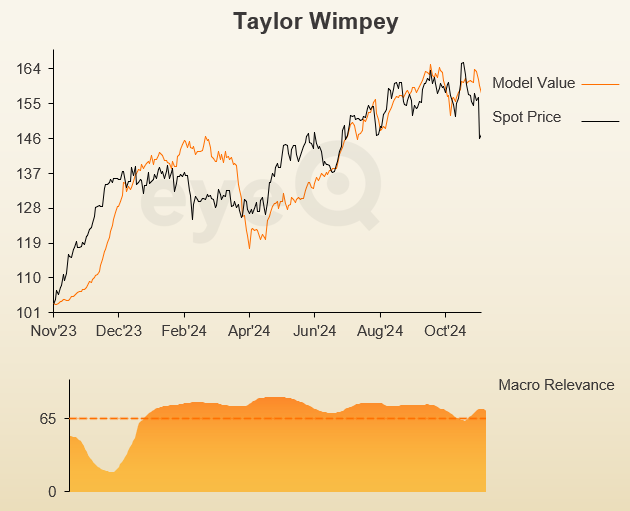eyeQ: UK homebuilders undervalued in Budget aftermath
Experts at eyeQ have used AI and their own smart machine to analyse macro conditions and generate actionable trading signals. Now it spots a good entry point for this FTSE 100 stock.
5th November 2024 11:16
by Huw Roberts from eyeQ

"Our signals are crafted through macro-valuation, trend analysis, and meticulous back-testing. This combination ensures a comprehensive evaluation of an asset's value, market conditions, and historical performance." eyeQ
- Discover: eyeQ analysis explained | eyeQ: our smart machine in action | Glossary
Taylor Wimpey
Macro Relevance: 72%
Model Value: 155.88p
Fair Value Gap: -5.99% discount to model value
Data correct as at 5 November 2024. Please click glossary for explanation of terms. Long-term strategic model.
The UK Budget unsettled markets last week, both equities and bonds. The 10-year gilt yield rose sharply in the aftermath, spooked by the loosening of fiscal rules to allow for a jump in borrowing. Not only are taxation and public spending levels reaching record peacetime levels, but borrowing is also forecast to rise.
In the stock market, the news reverberated most in those sectors deemed most rate sensitive, highly leveraged and domestic focused. At the index level, this was felt most in mid-caps. The more domestic FTSE 250 would be more sensitive to the risks on UK growth from the rise in employer National Insurance contributions.
At the sector level, the brunt of the losses was seen in UK homebuilders, with the Budget deemed to be delaying a decline in the UK rate path. The generous interpretation of the Budget would be that growth will follow and that the private sector will be incentivised to drive much-needed growth. Arguably, if gilt markets can stabilise from here, last week has presented an opportunity to identify undervalued homebuilders. While the correlation with gilt yields remains high, with de-regulation of planning approvals ahead of us, this sector will benefit from lower operational costs and speed to market.
Taylor Wimpey (LSE:TW.) fell almost 7% last Thursday before steadying on Friday. The stock has fallen back to its 200-day moving average i.e. its long-term trend. eyeQ’s smart machine shows the stock trading 6% below its model value – its largest discount since the spring (that was an opportune moment to buy), and among the largest discounts in the UK sector. See the chart below. The stock has remained well explained by eyeQ’s model with explanatory power high.
eyeQ shows the stock wants UK inflation expectations to continue to fall. Taylor Wimpey would benefit from rising real incomes and easing mortgage rates to boost buyer sentiment. This week, attention will shift to the US elections. There is a risk we see heightened volatility in US bond markets. However, any further weakness likely presents a good entry opportunity for the stock.

Source: eyeQ. Past performance is not a guide to future performance.
Useful terminology:
Model value
Where our smart machine calculates that any stock market index, single stock or exchange-traded fund (ETF) should be priced (the fair value) given the overall macroeconomic environment.
Model (macro) relevance
How confident we are in the model value. The higher the number the better! Above 65% means the macro environment is critical, so any valuation signals carry strong weight. Below 65%, we deem that something other than macro is driving the price.
Fair Value Gap (FVG)
The difference between our model value (fair value) and where the price currently is. A positive Fair Value Gap means the security is above the model value, which we refer to as “rich”. A negative FVG means that it's cheap. The bigger the FVG, the bigger the dislocation and therefore a better entry level for trades.
Long Term model
This model looks at share prices over the last 12 months, captures the company’s relationship with growth, inflation, currency shifts, central bank policy etc and calculates our key results - model value, model relevance, Fair Value Gap.
These third-party research articles are provided by eyeQ (Quant Insight). interactive investor does not make any representation as to the completeness, accuracy or timeliness of the information provided, nor do we accept any liability for any losses, costs, liabilities or expenses that may arise directly or indirectly from your use of, or reliance on, the information (except where we have acted negligently, fraudulently or in wilful default in relation to the production or distribution of the information).
The value of your investments may go down as well as up. You may not get back all the money that you invest.
Equity research is provided for information purposes only. Neither eyeQ (Quant Insight) nor interactive investor have considered your personal circumstances, and the information provided should not be considered a personal recommendation. If you are in any doubt as to the action you should take, please consult an authorised financial adviser.
Disclosure
We use a combination of fundamental and technical analysis in forming our view as to the valuation and prospects of an investment. Where relevant we have set out those particular matters we think are important in the above article, but further detail can be found here.
Please note that our article on this investment should not be considered to be a regular publication.
Details of all recommendations issued by ii during the previous 12-month period can be found here.
ii adheres to a strict code of conduct. Contributors may hold shares or have other interests in companies included in these portfolios, which could create a conflict of interests. Contributors intending to write about any financial instruments in which they have an interest are required to disclose such interest to ii and in the article itself. ii will at all times consider whether such interest impairs the objectivity of the recommendation.
In addition, individuals involved in the production of investment articles are subject to a personal account dealing restriction, which prevents them from placing a transaction in the specified instrument(s) for a period before and for five working days after such publication. This is to avoid personal interests conflicting with the interests of the recipients of those investment articles.